11 Mustangs that never came to be
The Ford Mustang’s path from affordable coupe to performance icon has taken many twists and turns in its nearly 60-year history. Built on a platform similar to that of Ford’s econo-oriented Falcon when it was first introduced as a mid-year model in 1964, the Mustang pulled much of its styling inspiration from the Allegro concept that had appeared the year before, and its formula of small car plus V-8 engine would set the tone for the next six decades of its existence.
At least, that’s what happened in our timeline. The alternate history of the Ford Mustang—the one that never came to be—shot off in all sorts of weird and wonderful directions, buffeted by the winds of market change, the addled dreams of designers chasing the latest trends, and the vagaries of engineers dazzled by the latest technologies.
Check out these Mustangs that might have been, but never were.
The sedan

Two early “what if” branches of the family tree illustrated what the Mustang lineup could have looked like had it expanded into a more complete portfolio of cars. Instead, it aimed at satisfying performance fans later and those seeking an inexpensive commuter early on.
The wagon
While the four-door Mustang sedan concept, built in 1965, never made it anywhere past the designer’s studio, a two-door wagon (or shooting brake) version of the car had much longer legs. The fevered dream of three Ford fans—including Robert Cumberford (designer), Barney Clark (Blue Oval ad exec), and Jim Licata (partner in crime)—the cargo-friendly Mustang was converted from a coupe that had been sent to Italy’s Costruzione Automobili Intermeccanica that same year.
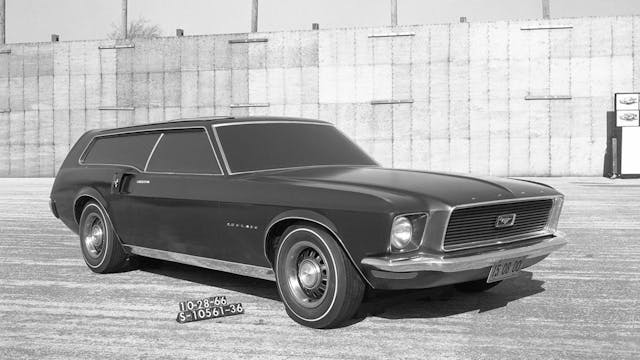
When the finished product came back, the trio took it to Ford, Holman Moody, and even independent automotive production companies, all of whom passed on putting it into production. While the original is lost to the mists of time, a number of individuals and aftermarket companies have produced their own Mustang wagon replicas based on its design, giving us a glimpse back at a history that never happened for a car that never officially existed.
Mustang II: A bigger Maverick?
It’s interesting that the most lamented member of the Mustang fold was also the one that underwent such a far-ranging design process before being birthed into the world.
By the early ’70s it was clear that Ford would have to make some choices about the future of the coupe, given impending EPA regulations about fuel economy, the precarious world energy situation, and changing crash-test regulations. This meant a crossroads for the Mustang, and some incredibly out-there looks at what the next-generation Mustang II could be.
Initially, Ford tried to retain the car’s original platform and give it a much longer, personal-luxury type of design, but it became clear that wouldn’t work. A second swipe at the O.G. platform produced something that looked more like an enlarged Maverick than it did a Mustang.

Two crucial interventions in the Mustang II process led the company to the eventual production car: a decision to shrink the coupe’s wheelbase (and work a partnership with Ghia).
Ghia’s nose jobs

By 1971, Ford was producing Mustang concepts at a startling rate. At first, the smaller Ghia-assisted prototypes still embodied the upright, premium coupe look that had been seen on the larger models, both with a shark-nosed element that was clearly European, and without, in a style that would be seen later on vehicles like the Granada.
Japanese-esque hatch
Where things really got interesting was when the Ghia studio jumped well outside the box of the decade’s styling trends and offered a hatchback version of the Mustang II that, seen in hindsight, could easily have leapt forth from the production lines of a Japanese manufacturer like Datsun or Mitsubishi in the early ’80s. Arguably, this is a far cleaner design than the actual production Mustang II, but it’s difficult to project how a look that was so far ahead of its time would have been received by a market that was still staggering out of the muscle car era.
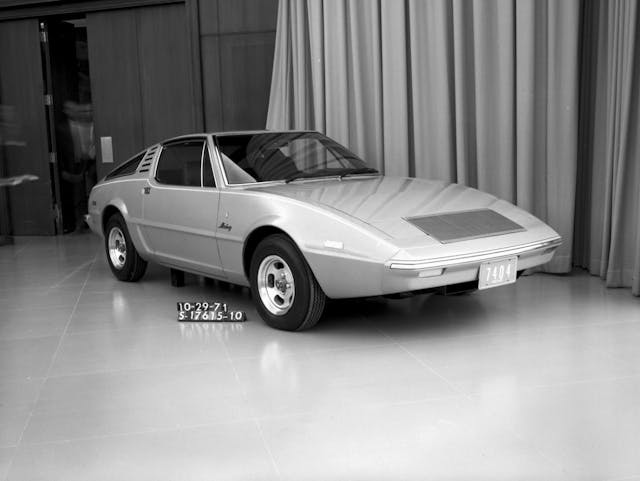
The Probe that almost became a pony
Ghia’s prescient hatch was a harbinger of the existential crisis that would strike the Mustang in the mid-’80s. Swamped by strong-selling imports, and convinced that the market for traditional, rear-wheel-drive, V-8 coupes was about to drop off a cliff, Ford partnered with Mazda to produce the anti-Mustang, which was dubbed the SN-16.
Although the styling never moved past this clay model (which displays the grille-mounted pony logo running in the opposite direction, presumably as a sign of distress), engineering teams were hard at work on a new platform for the car, and by the time testing began in 1987, FoMoCo fans were up in arms about the proposed drive-wheel switch for the Mustang and mounted a letter-writing campaign that deep-sixed the idea.
If this front-wheel-drive jelly bean looks familiar, however, that’s because it would eventually find its way to the market as the Ford Probe in 1988, a coupe that never really resonated with the performance crowd (and which was kissing cousin to the Mazda MX-6).
Three action heroes, one rescued icon
It’s no surprise that Ford’s sudden about-face seriously impacted the development of the Mustang’s replacement. Initially, the company simply continued to sell the Fox-platform car alongside the Probe, delaying its replacement in part because the front-wheel-drive experiment had soaked up so many development dollars. Not only that, but the Blue Oval continued to dump cash into front-wheel-drive pony car development at the same time as it pursued a new, rear-wheel-drive platform for the Mustang because it was unwilling to simply walk away from the sunk cost.
By 1990 it became clear that an eight-cylinder, front-wheel-drive Mustang was a non-starter, but by that time there wasn’t much cash left in the coffers to get truly radical with the vehicle’s styling or chassis. The end result was the SN95 platform, also known as Fox-4, which simply updated aspects of the original Fox and allowed for the eventual inclusion of Ford’s modular 4.6-liter V-8.

A reheated Fox might have spelled disaster for the Mustang if it not for the idea of latching on to heritage elements from the original design and baking them in to the new model. One of the first of the modern retro cars that would come to define a certain slice of ’90s automotive styling, the SN95 Mustang’s potential looks were whittled down to three contenders, each named after a popular action star of the day,
The “Bruce Jenner” design clearly displays elements that would go on to eventual production in both the Ford Contour and redesigned Ford Taurus sedans, but its smooth lines were considered too soft for the Mustang.
The “Rambo” was a much more aggressive liftback design that seemingly shared its inspiration with GM’s radically redesigned F-body Camaros and Firebirds that would also debut around the same time. It was seen as more extroverted than what Mustang fans would accept.
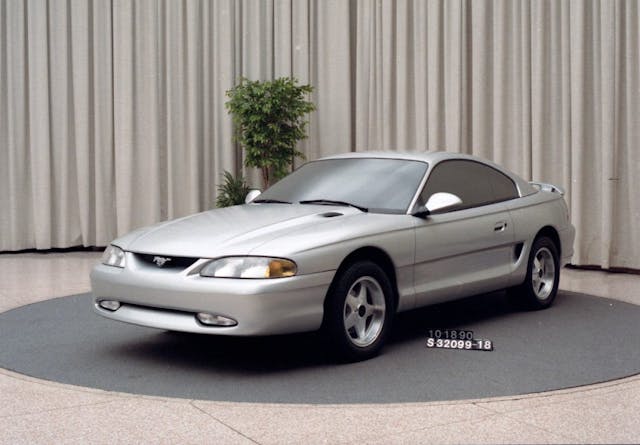
The “Schwarzenegger” was the model that would eventually find its way into production, a car that featured the familiar, large side scallops that evoked the original Mustang design, as well as the long hood and short rear deck evocative of the early coupes. It was this look that would lead to a dramatic surge in sales for the pony car and once again make it relevant in the world of both performance and style.
Two other intriguing silhouette sketches of the fourth-generation Mustang also show how designers of the same era share much of the same mental real estate when exploring potential concepts. One features inspiration drawn from the Mercedes-Benz SL-Class coupe, while the other depicts a startling prediction of what Dodge’s upcoming Avenger would look like a few years down the road.
Interestingly, a combination of the Rambo and the Schwarzenegger designs was also built, and it’s hard not to look at it without seeing the face of the Oldsmobile Alero that would hit the streets less than a decade later. Woof.
Check out the Hagerty Media homepage so you don’t miss a single story, or better yet, bookmark us.
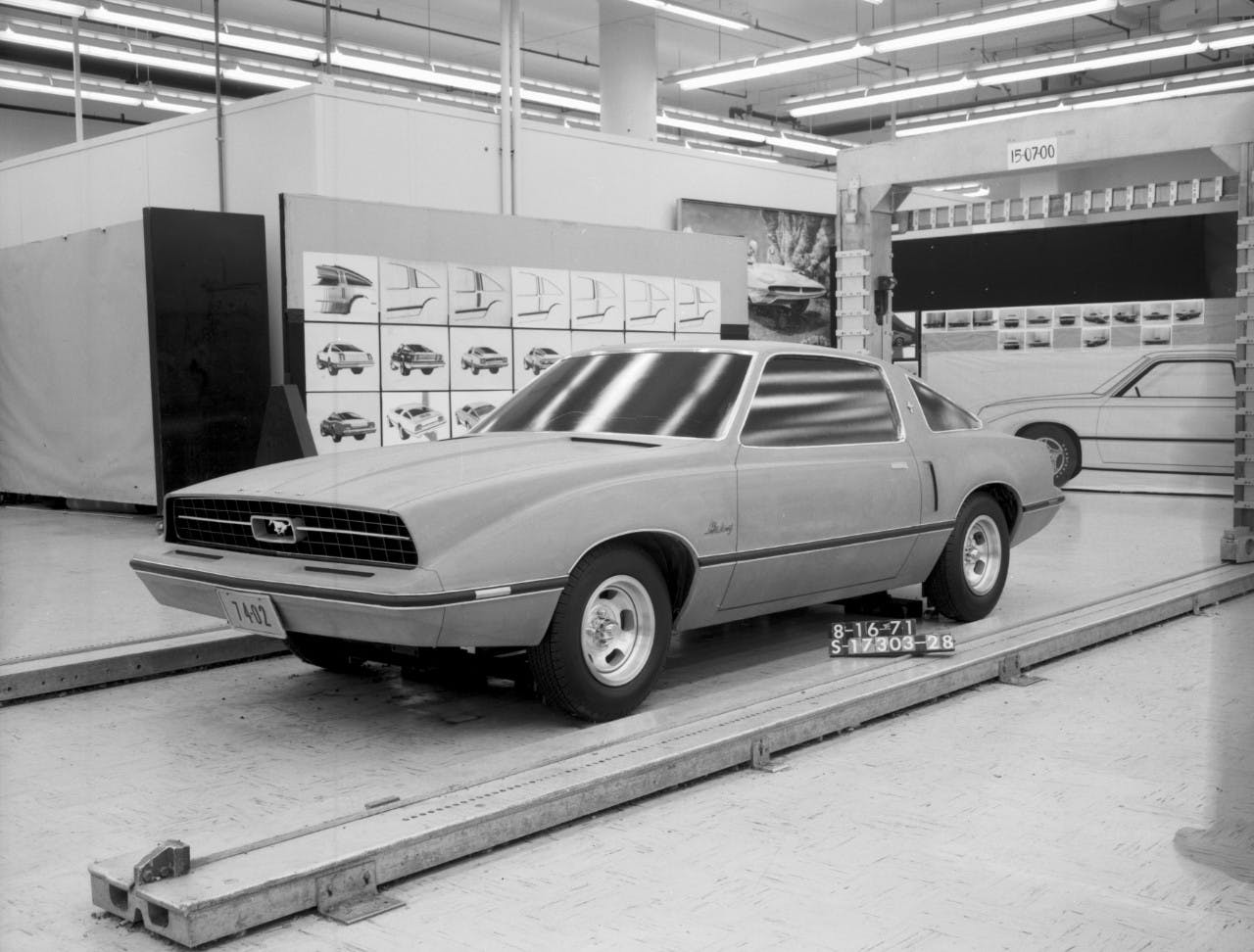
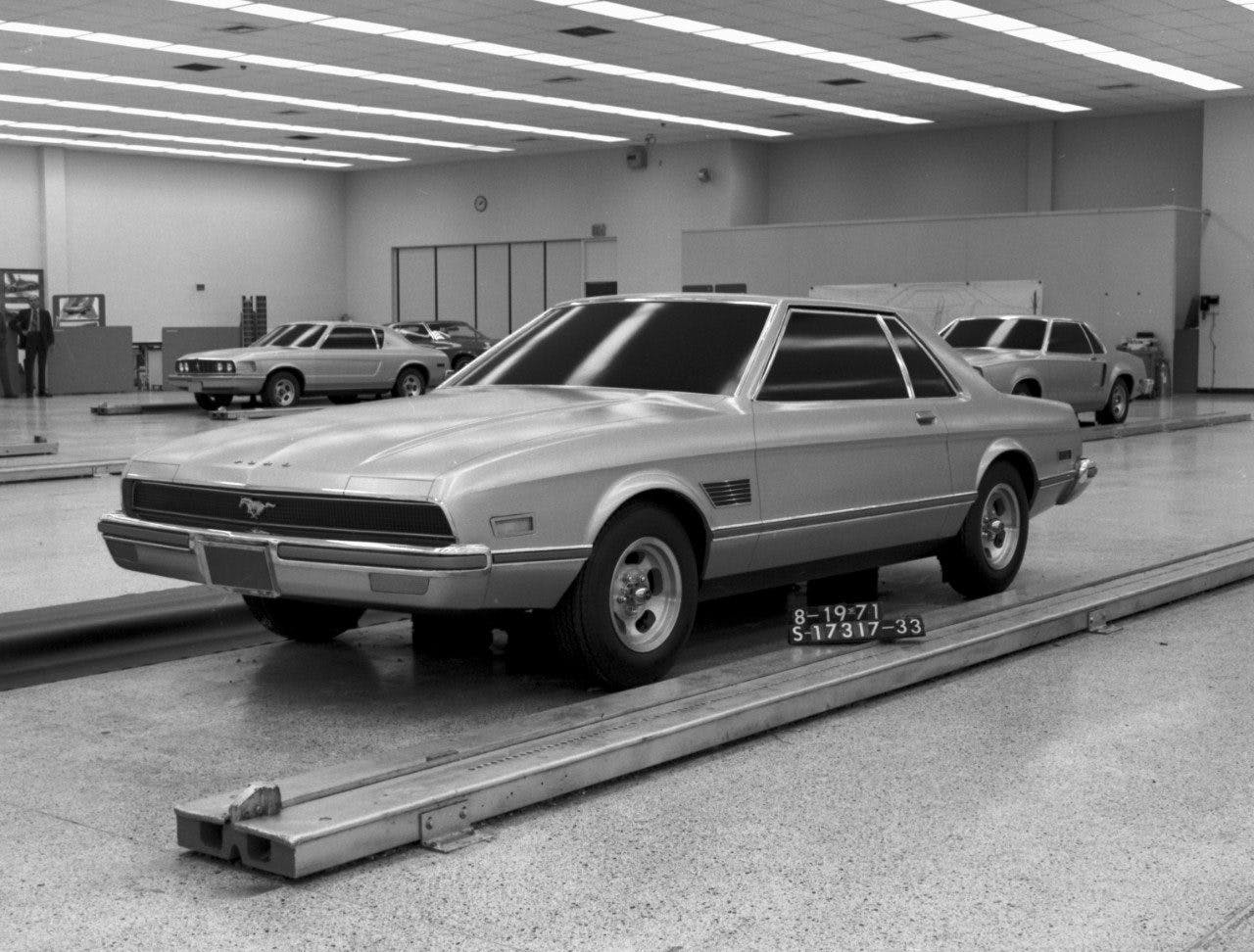
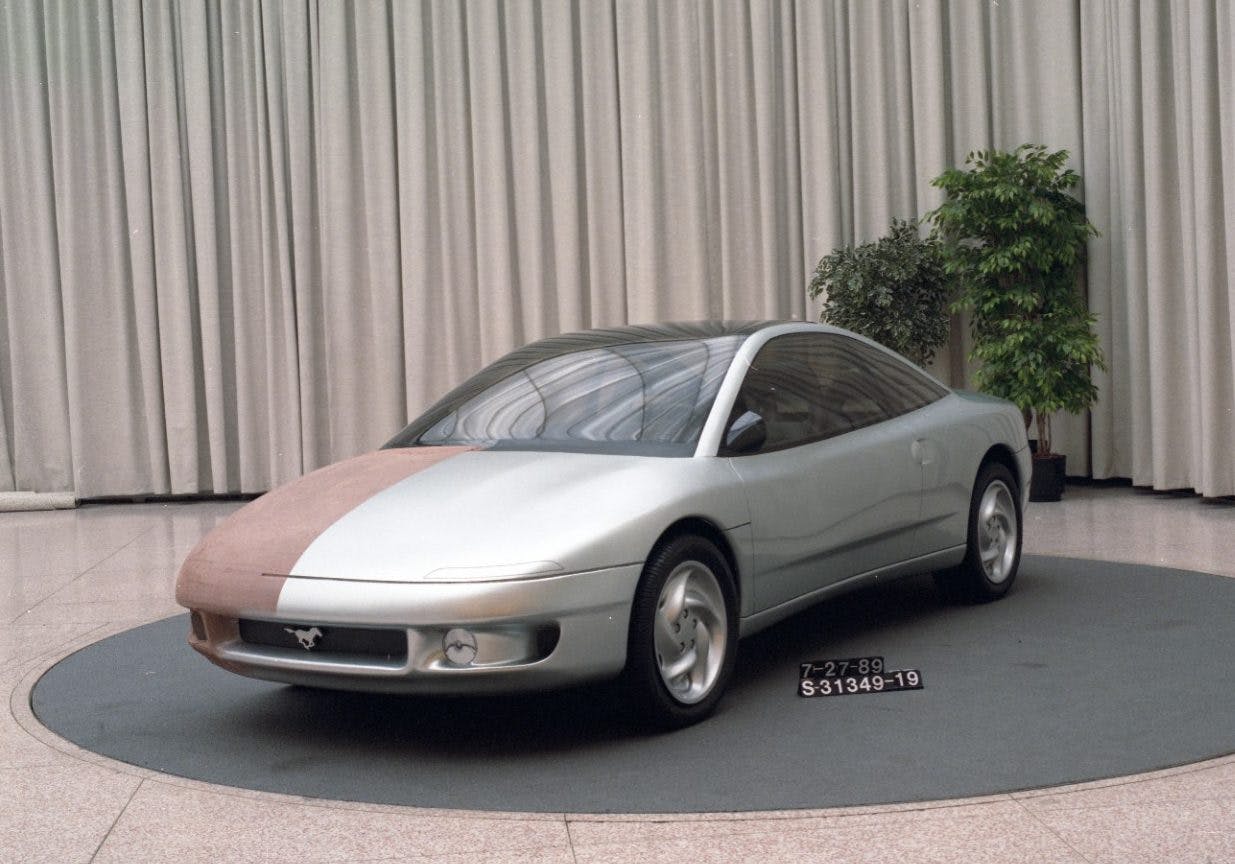
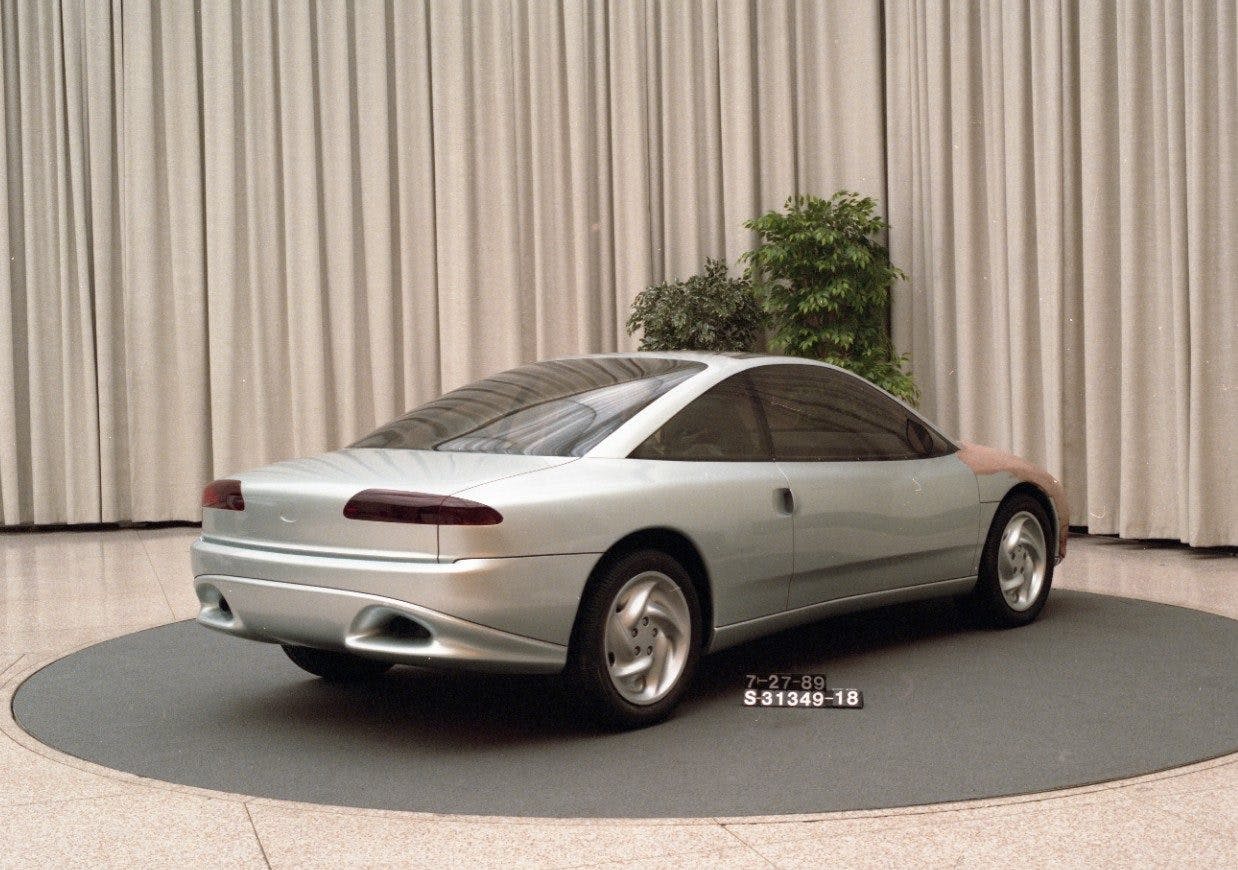
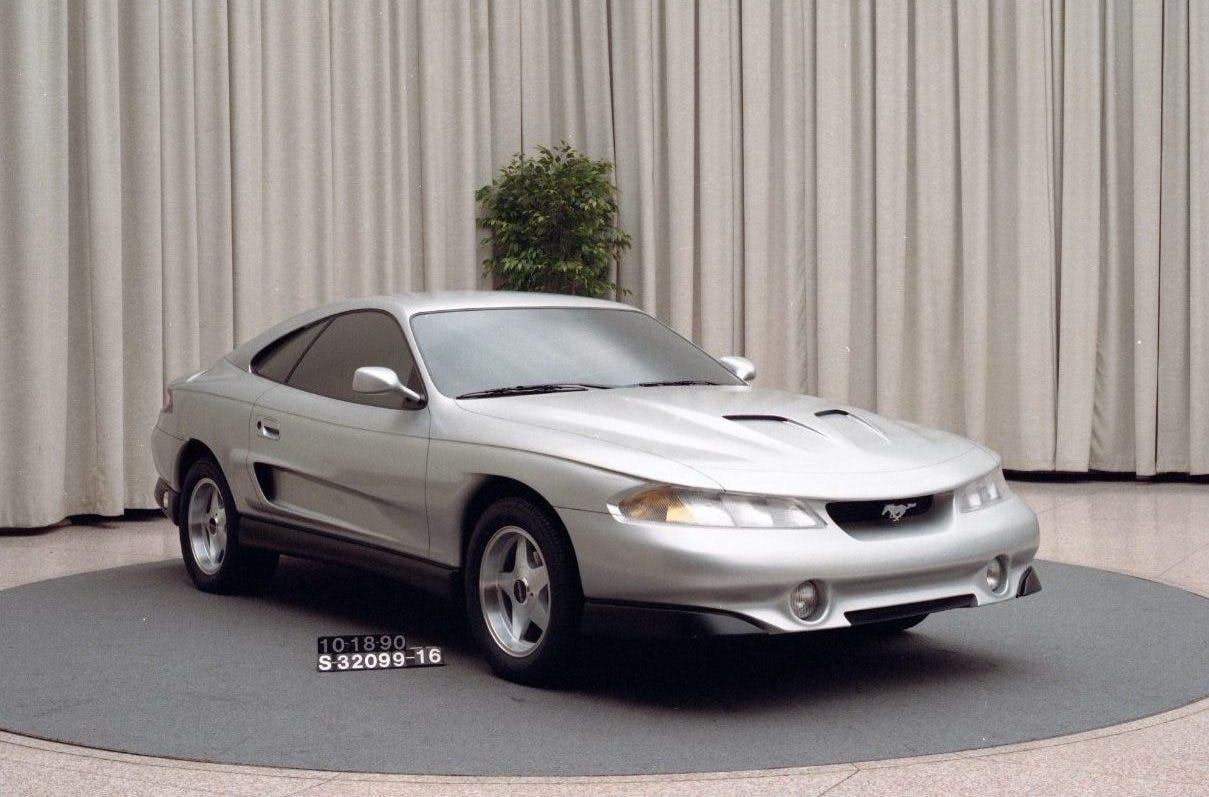
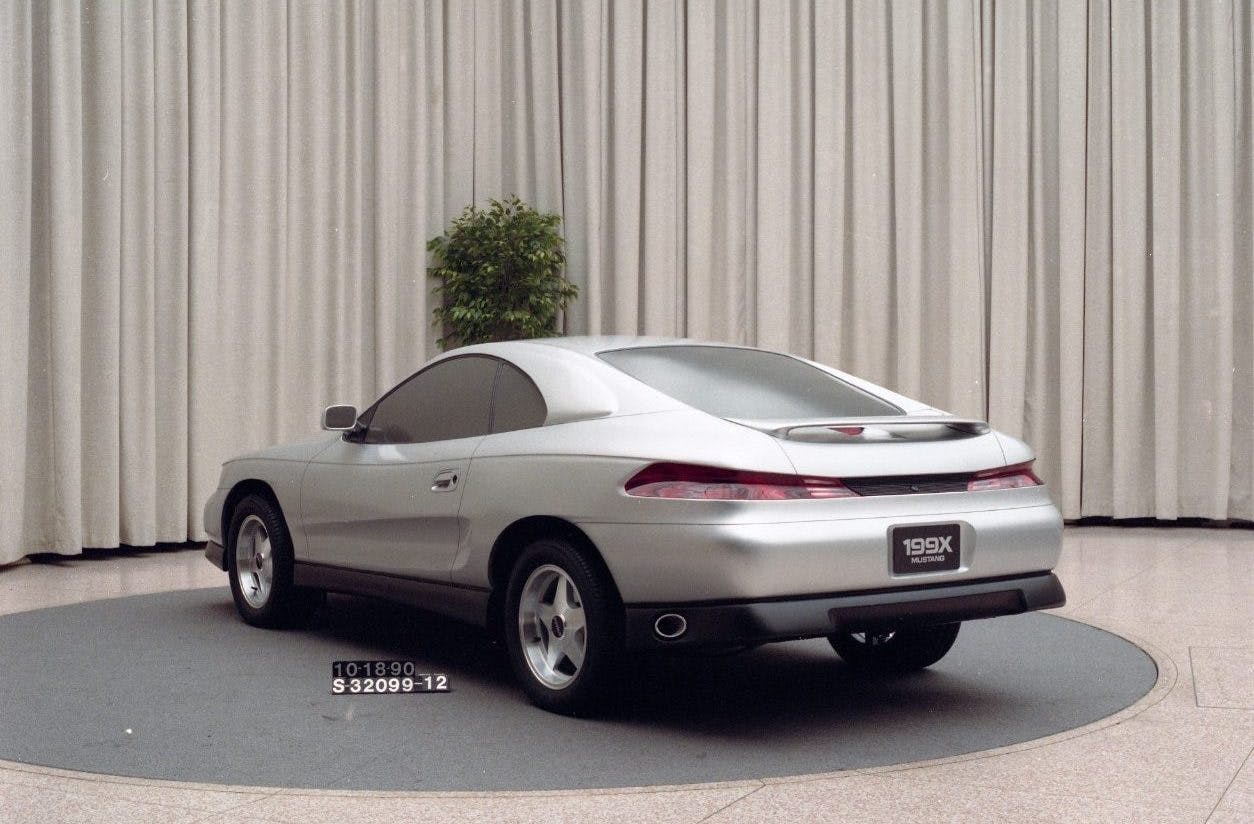
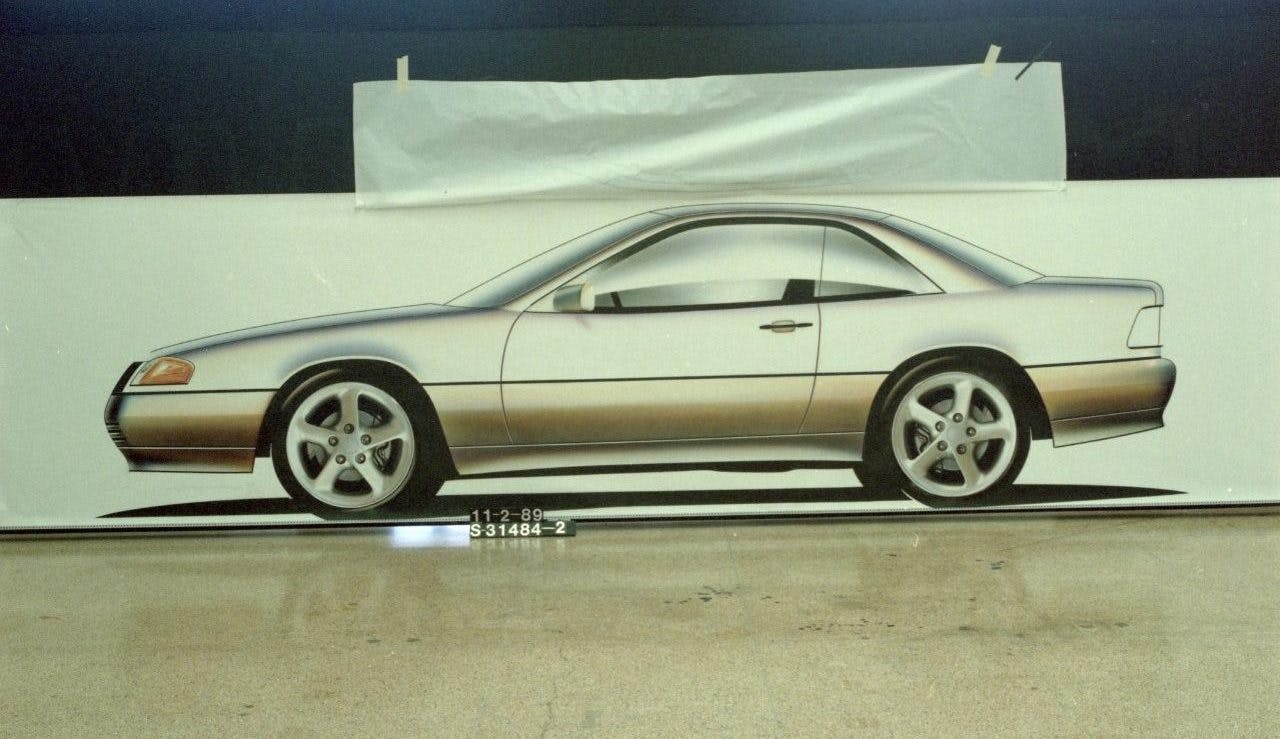
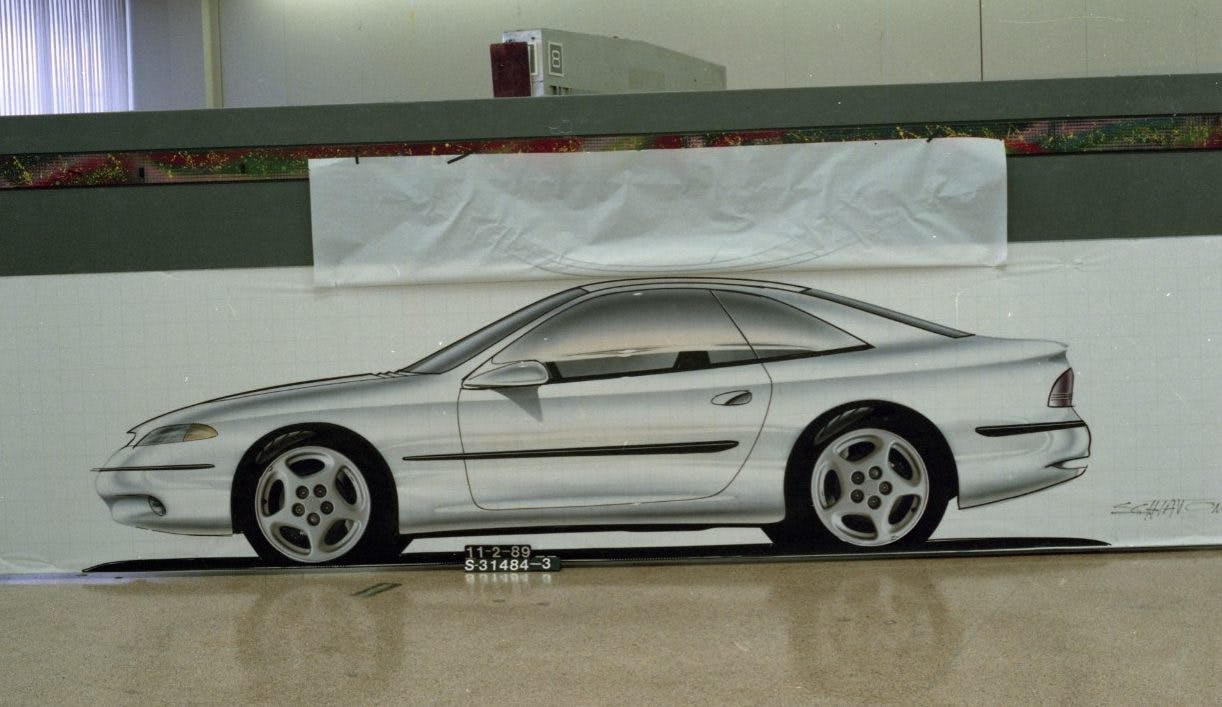
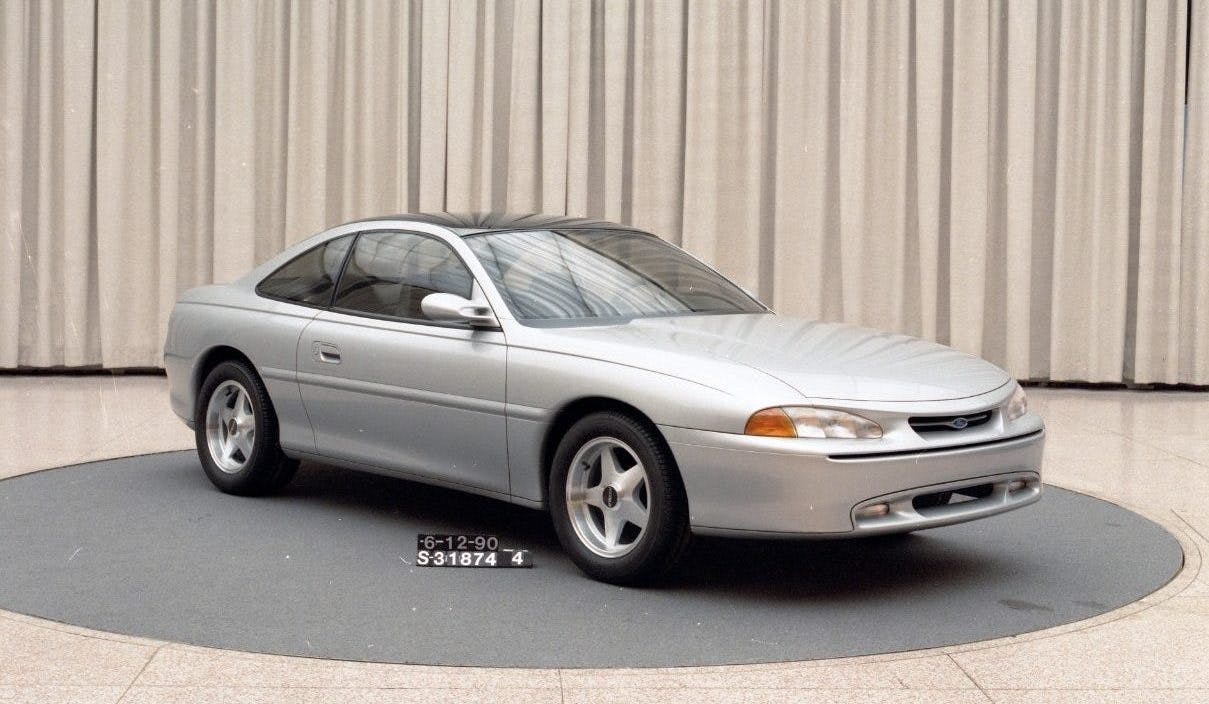
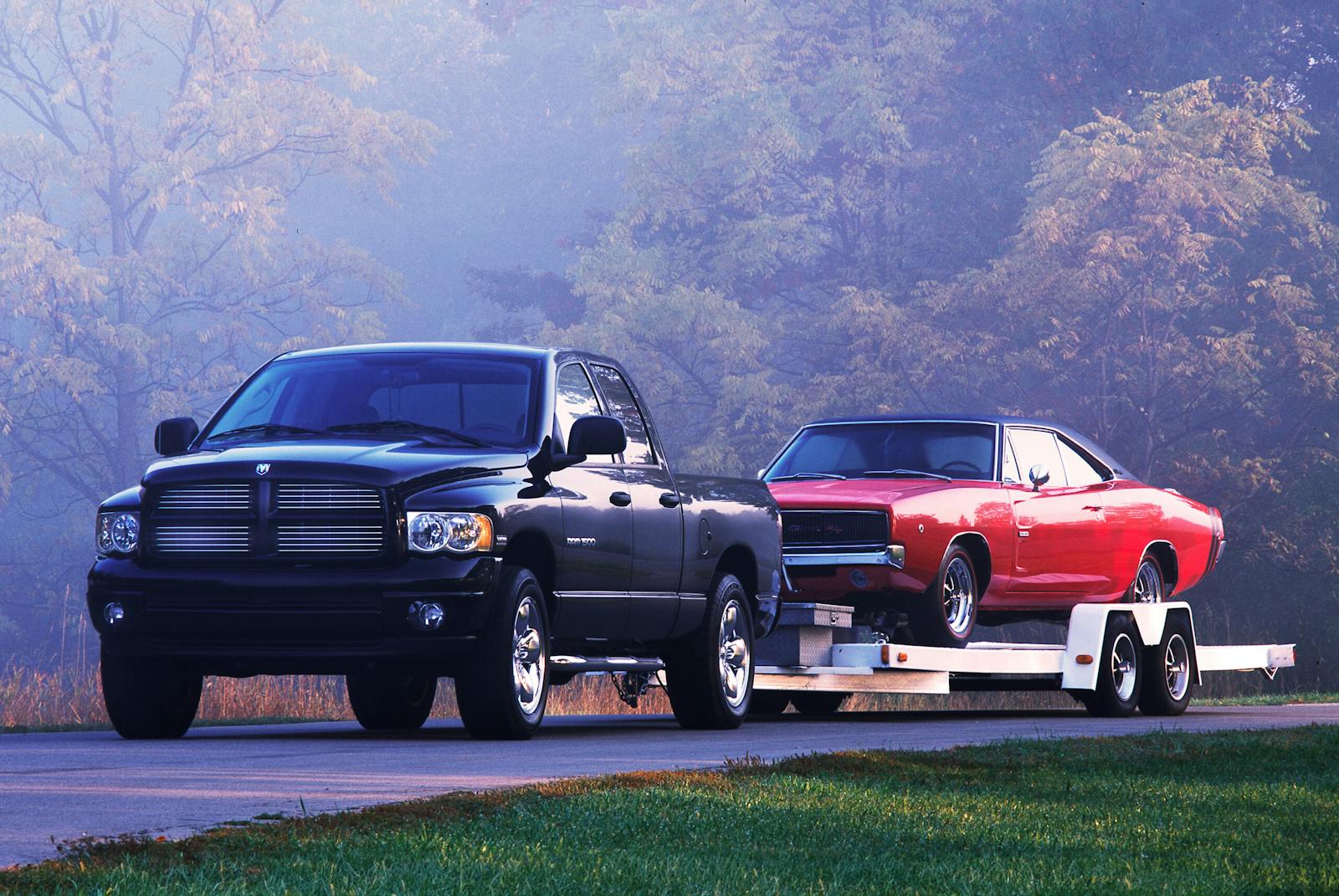
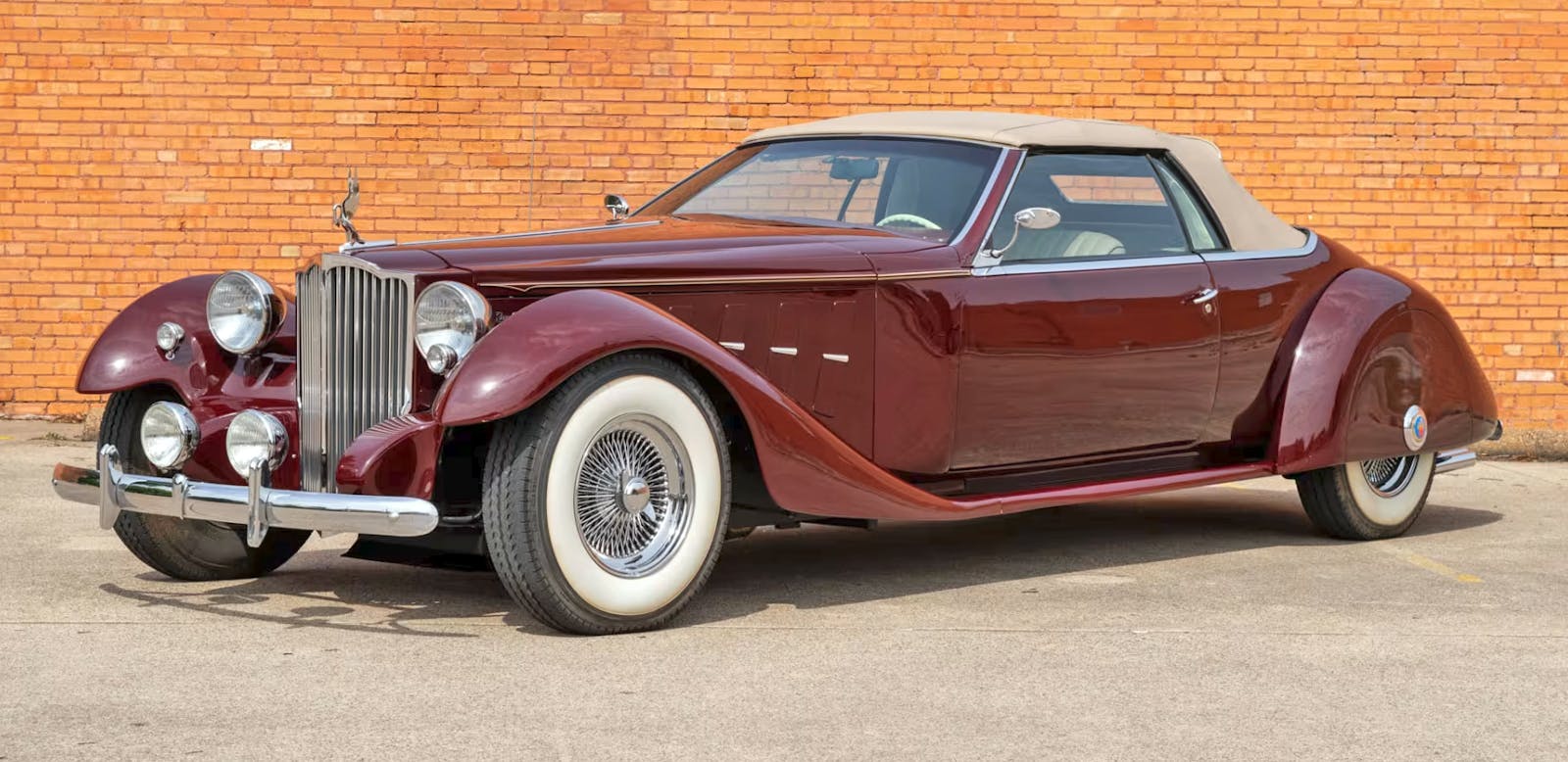
The new E-Stang should have been on that list.
But that wagon shouldn’t. That this is hot!
Agreed. The E-Stang looks hideous. Kinda makes you wonder which Ford relative is a fan of this. The design should have been killed off with many of the ones pictured here.
Being a family man and having owned wagons from Ford escorts to Chrysler Town and Country, and a hot rodder at heart, I’m sure there would have been a Mustang, especially a two door. I would most likely still be driving it
Mustang’s various versions ran the entire spectrum from some of the best cars ever made to some of the worst.
Switching back and forth, Ford just couldn’t decide which design was best…especially the Bruce Jenner.
The wagon, that is a very neat car. Think it would sell great today.
I don’t think the wagon would have made it. Did Chrysler see that concept when they built the Pacifica?
The wagon! I’ve seen pictures of it before and always wondered they didn’t follow through with it.
Naming this 4 door EV thing Ford is pushing Mustang insults the Mustang name.
Cars with four doors ARE NOT MUSTANGS! They are called Falcons.
and while we’re ranting…
4x4s with four doors ARE NOT BRONCOS! They’re called Excursions.
Just like Chrysler had success with redoing some retro looking cars. I think if Ford made that Mustang Wagon, and really kept the true look, I think it could be a success
I attended the L.A. Car show in +/-1963 which featured a Mustang prototype that really excited me. It was a two seat roadster. Unfortunately, it was not produced.
I like the wagon, reminds me of Mopar’s magnum model.
Looks similar to a Chevy Nomad.
Agreed that the E-Mustang should’ve been on that list! Hideous!!! What were they thinking…best guess is they wanted it to flop so they could say could say the public isn’t ready for an E muscle car, and keep making those sexy, beefy sounding, (and great selling) V-8’s that we all love to see and hear tearing up n down Woodward Ave.
Though I’m partial to station wagons…(loved my two 1968 Vista Cruisers) the s.w. Mustang reminded me of the Pinto wagon, which was ok for a Pinto to do, but putting a wagon ass-end on a ‘Stang would’ve been akin to putting a big booty on Farrah Fawcett at the time! (though, how many of us that enjoyed looking at Farrah would’ve noticed she had a big booty? lol).
I like the 4 door the best, next to the original coupe. Wierd but eye catching. 🙂